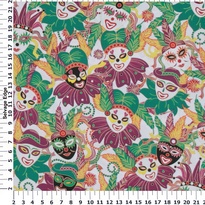**I wrote this blog post last year and I have yet another reason why I don't like blackout for roman shades.
Update at the end.
When I was a child and growing up in my parents home, I had to have all the lights off to sleep. Even lights outside my bedroom. If there was even the smallest amount of light to be seen from underneath the door, I just couldn't sleep. I'd go out in the hall and turn off the lights only to have my brother immediately turn them back on. He used to say, "Why don't you sleep with your eyes closed like the rest of the human race?" I am a huge fan of blackout lining.
We carry the ever popular blackout lining to line our curtains. First and foremost, let's clear up one misnomer. People think blackout lining is black. It is not. We carry both white and ivory/ecru blackout liner.
There are many great thing about blackout: It blocks light, it insulates, it is machine washable, it keeps the color from fading on your curtains as well as on other items in a room that may get a lot of direct sunlight. But, blackout may not be ideal for everyone. It has a few downsides too.
The following curtains are lined in regular drapery lining, not blackout.


The following sets of curtains are lined in blackout liner.


It is clear that blackout makes a tremendous difference. I definitely recommend on curtains! However, roman shades are a different story.
In constructiong a roman shade we must sew dowel rod cases through the front and back of the shade at about every ten inches down the shade. When the needle goes through the blackout it removes it from the lining and you can see each and every needle hole. And guess what else? We're human! Surprise! This means that sometimes we do not get the dowel rod casing line completely straight all the way across. We do notice this sometimes, but the alternative is to take out the stitching and make it straight. If it does not interfere with the over all quality of the shade we will usually leave an uneven line since removing the stitching makes it so you can see both the straight line and the mistake.
If using white fabric, the blackout material comes through the holes and makes little black marks on the shade around the outside of these holes.
Notice the needle pin holes and uneven lines. If you are one that is easily bothered by details, being able to see the light through these pin holes may become quite bothersome to you over time. If you are one of these people, I would recommend drapery lining.
Drapery lining will also block light and keep the furniture in your room from fading, however it will not block it out completely and it will not keep the fabric on the window treatment itself drom fading.
Over all, I recommend using blackout on curtains and not roman shades. But I do have babies and know the sun is their alarm clock. So if you don't think the pin holes will be a bother to you, then the blackout is great for the romans too.
Feel free to ask me any questions you may have about blackout or drapery lining.
UPDATE:
When sewing roman shades we have to sew the dowel rod cases, or ribbing, to the main fabric and the lining in order for the shade to roll up correctly. The shade is mounted on a mounting block with Velcro. We also have to sew that Velcro to the top of the shade. When we sew with blackout the blackout comes up with the sewing needle and completely damages the fabric. Long story short, blackout isn't all its cracked up to be.












































